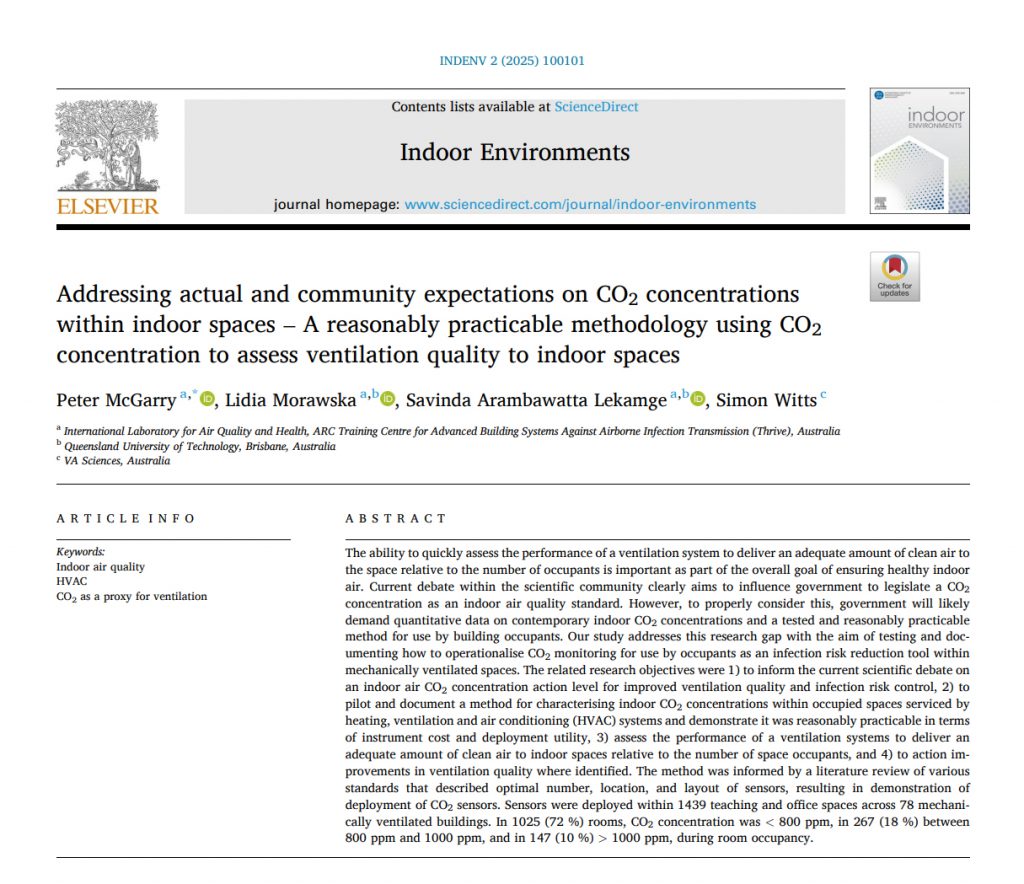
🚨New paper published by members of the Thrive IAQ team including: Dr Peter McGarry (The University of Queensland), Prof Lidia Morawska (QUT (Queensland University of Technology)), Ms Savinda Heshani (QUT), and Simon Witts (VA Sciences).
This paper titled, “𝗔𝗱𝗱𝗿𝗲𝘀𝘀𝗶𝗻𝗴 𝗮𝗰𝘁𝘂𝗮𝗹 𝗮𝗻𝗱 𝗰𝗼𝗺𝗺𝘂𝗻𝗶𝘁𝘆 𝗲𝘅𝗽𝗲𝗰𝘁𝗮𝘁𝗶𝗼𝗻𝘀 𝗼𝗻 𝗖𝗢𝟮 𝗰𝗼𝗻𝗰𝗲𝗻𝘁𝗿𝗮𝘁𝗶𝗼𝗻𝘀 𝘄𝗶𝘁𝗵𝗶𝗻 𝗶𝗻𝗱𝗼𝗼𝗿 𝘀𝗽𝗮𝗰𝗲𝘀 – 𝗔 𝗿𝗲𝗮𝘀𝗼𝗻𝗮𝗯𝗹𝘆 𝗽𝗿𝗮𝗰𝘁𝗶𝗰𝗮𝗯𝗹𝗲 𝗺𝗲𝘁𝗵𝗼𝗱𝗼𝗹𝗼𝗴𝘆 𝘂𝘀𝗶𝗻𝗴 𝗖𝗢𝟮 𝗰𝗼𝗻𝗰𝗲𝗻𝘁𝗿𝗮𝘁𝗶𝗼𝗻 𝘁𝗼 𝗮𝘀𝘀𝗲𝘀𝘀 𝘃𝗲𝗻𝘁𝗶𝗹𝗮𝘁𝗶𝗼𝗻 𝗾𝘂𝗮𝗹𝗶𝘁𝘆 𝘁𝗼 𝗶𝗻𝗱𝗼𝗼𝗿 𝘀𝗽𝗮𝗰𝗲𝘀”, published in the 𝘐𝘯𝘥𝘰𝘰𝘳 𝘌𝘯𝘷𝘪𝘳𝘰𝘯𝘮𝘦𝘯𝘵𝘴 journal, aimed to test and document how to operationalise CO2 monitoring for use by occupants as an infection risk reduction tool within mechanically ventilated spaces. Here are some highlights from the paper:
👉 A method was tested to simultaneously monitor CO2 concentrations in situ in multiple spaces of a building.
👉 Operationalises CO2 monitoring for use by building operators as an infection risk reduction tool.
👉 Monitoring conducted in 1439 occupied rooms showed CO2 concentration < 800 ppm in 1025 (72%) spaces, between 800 ppm and 1000 ppm in 267 (18%) and > 1000 ppm in 147 spaces (10 %).
👉 In many cases assumptions that ventilation complied with relevant ventilation standards were incorrect.
Read the paper 🔗: https://doi.org/10.1016/j.indenv.2025.100101